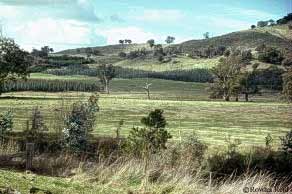|
|
|
Planting Trees to Reduce Waterlogging &
Salinity

There are four factors that can be manipulated when designing
revegetation systems for controlling dryland salinity. These
are:
• The area planted with trees as a percentage of the
catchment;
• The arrangement of trees within the catchment (alleys,
blocks, wide spaced, etc);
• The location of trees within the catchment (soil type,
recharge or discharge area, low or high in the landscape,
etc);
• The tree species selected (water use, leaf area index,
growth habit, etc).
The effectiveness of a revegetation strategy to control salinity
will depend on the processes occurring within the catchment
as indicated by the:
• Discharge capacity of the aquifer;
• Size of the groundwater systems (local, intermediate
or regional);
• Spatial distribution of recharge (localised to particular
sites or covering a wide area);
• Salinity levels in the groundwater;
• Frequency and timing of recharge events (seasonal or
only after particular rainfall events).
Being able to match the potential of trees to particular processes
occurring in a catchment can be a major challenge. In many
cases large areas of revegetation may be required on many
farms across a region. In some cases, commercial tree growing
options will be available that are attractive to farmers and
allow them to convert large areas to perennial tree cover.
However, in most cases the location where the trees must be
grown for the control of salinity will be of low value for
commercial tree growing due to low productivity, difficult
access or the risk of drought and salt accumulation. For this
reason a range of revegetation strategies are currently being
explored including: growing trees in short term rotations
with agriculture to dry the soil to depth, establishing trees
in belts across the slope to intercept subsoil drainage, mixing
trees with agriculture in belts or wide spaced trees; and
establishing blocks of trees over shallow watertables.
Back to top
|
